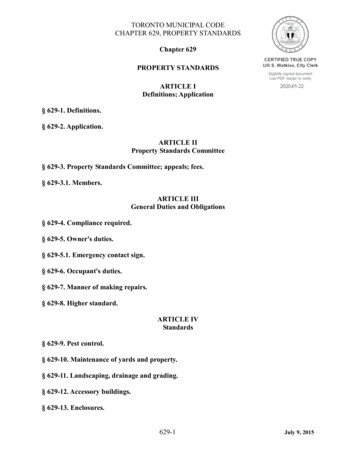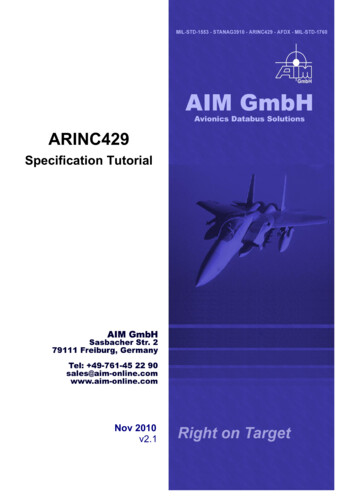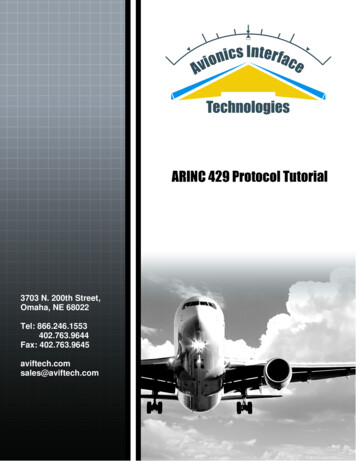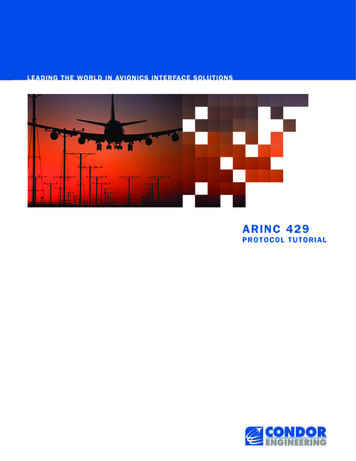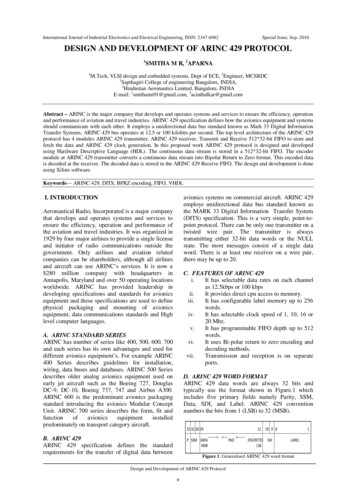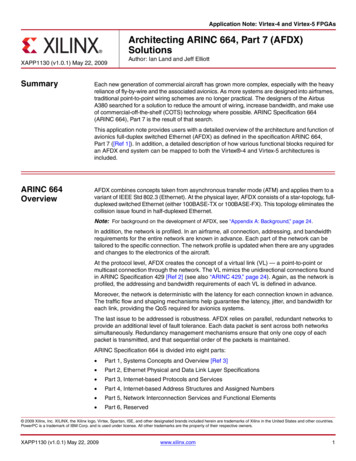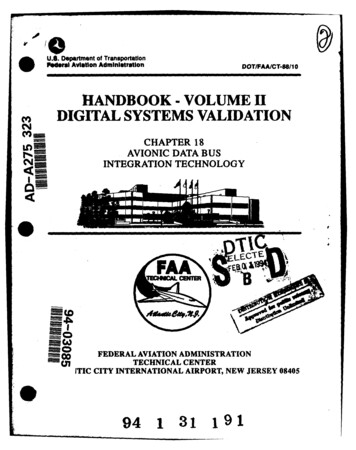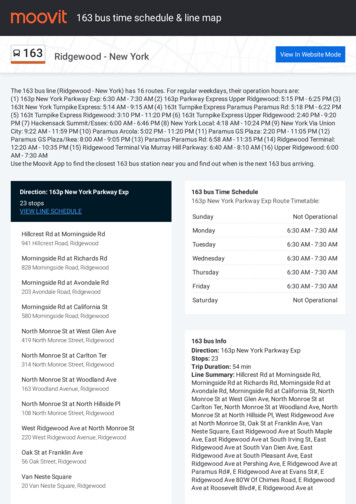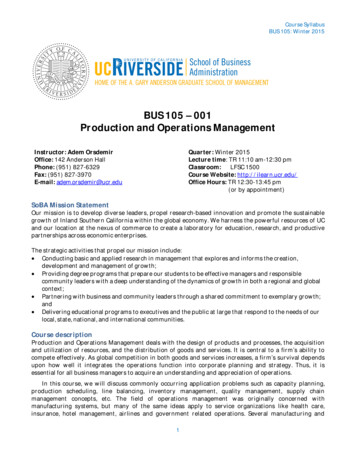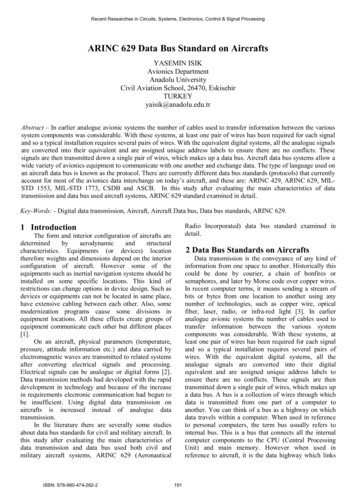
Transcription
Recent Researches in Circuits, Systems, Electronics, Control & Signal ProcessingARINC 629 Data Bus Standard on AircraftsYASEMIN ISIKAvionics DepartmentAnadolu UniversityCivil Aviation School, 26470, EskisehirTURKEYyaisik@anadolu.edu.trAbstract – In earlier analogue avionic systems the number of cables used to transfer information between the varioussystem components was considerable. With these systems, at least one pair of wires has been required for each signaland so a typical installation requires several pairs of wires. With the equivalent digital systems, all the analogue signalsare converted into their equivalent and are assigned unique address labels to ensure there are no conflicts. Thesesignals are then transmitted down a single pair of wires, which makes up a data bus. Aircraft data bus systems allow awide variety of avionics equipment to communicate with one another and exchange data. The type of language used onan aircraft data bus is known as the protocol. There are currently different data bus standards (protocols) that currentlyaccount for most of the avionics data interchange on today’s aircraft, and these are: ARINC 429, ARINC 629, MILSTD 1553, MIL-STD 1773, CSDB and ASCB. In this study after evaluating the main characteristics of datatransmission and data bus used aircraft systems, ARINC 629 standard examined in detail.Key-Words: - Digital data transmission, Aircraft, Aircraft Data bus, Data bus standards, ARINC 629.Radio Incorporated) data bus standard examined indetail.1 IntroductionThe form and interior configuration of aircrafts tics. Equipments (or devices) locationtherefore weights and dimensions depend on the interiorconfiguration of aircraft. However some of theequipments such as inertial navigation systems should beinstalled on some specific locations. This kind ofrestrictions can change options in device design. Such asdevices or equipments can not be located in same place,have extensive cabling between each other. Also, somemodernization programs cause some divisions inequipment locations. All these effects create groups ofequipment communicate each other but different places[1].On an aircraft, physical parameters (temperature,pressure, attitude information etc.) and data carried byelectromagnetic waves are transmitted to related systemsafter converting electrical signals and processing.Electrical signals can be analogue or digital forms [2].Data transmission methods had developed with the rapiddevelopment in technology and because of the increasein requirements electronic communication had begun tobe insufficient. Using digital data transmission onaircrafts is increased instead of analogue datatransmission.In the literature there are severally some studiesabout data bus standards for civil and military aircraft. Inthis study after evaluating the main characteristics ofdata transmission and data bus used both civil andmilitary aircraft systems, ARINC 629 (AeronauticalISBN: 978-960-474-262-22 Data Bus Standards on AircraftsData transmission is the conveyance of any kind ofinformation from one space to another. Historically thiscould be done by courier, a chain of bonfires orsemaphores, and later by Morse code over copper wires.In recent computer terms, it means sending a stream ofbits or bytes from one location to another using anynumber of technologies, such as copper wire, opticalfiber, laser, radio, or infra-red light [3]. In earlieranalogue avionic systems the number of cables used totransfer information between the various systemcomponents was considerable. With these systems, atleast one pair of wires has been required for each signaland so a typical installation requires several pairs ofwires. With the equivalent digital systems, all theanalogue signals are converted into their digitalequivalent and are assigned unique address labels toensure there are no conflicts. These signals are thentransmitted down a single pair of wires, which makes upa data bus. A bus is a collection of wires through whichdata is transmitted from one part of a computer toanother. You can think of a bus as a highway on whichdata travels within a computer. When used in referenceto personal computers, the term bus usually refers tointernal bus. This is a bus that connects all the internalcomputer components to the CPU (Central ProcessingUnit) and main memory. However when used inreference to aircraft, it is the data highway which links191
Recent Researches in Circuits, Systems, Electronics, Control & Signal Processingone computer to another within the aircraft, for example,the FMC (Flight Management Computer) and the ADC(Air Data Computer) [4,5].Bus systems provide an efficient means ofexchanging data between the diverse avionic systemsfound in a modern aircraft as shown in Figure 1 [6].All buses consists of two parts an address bus and adata bus. The data bus transfers actual data whereas theaddress bus transfers information about where the datashould go. On an aircraft bus, the two parts areincorporated within a single data word.A bus can be either serial or parallel. A serial busrequires less wiring, but is slower. A parallel busrequired one wire for each bit within the data word, butis much faster. Aircraft bus systems use serial datatransfer because it minimizes the size and weight ofaircraft cabling. With such a large number of avionicsystems, a modern aircraft requires a considerableamount of cabling. Furthermore, some of the cablingruns in a large aircraft can be quite lengthy. Aircraftcabling amounts to a significant proportion of theunladen weight of an aircraft and so minimizing theamount of cabling and wiring present is an importantconsideration in the design of modern aircraft, both civiland military.Primary FlightComputersAutopilotDirectorComputersA bus can enable communication between a singlecomputer to a single LRU (Line Replaceable Unit) only,known as single source-single sink or a single computerto multiple LRUs, known as single source-multiple sink,or multiple computers to multiple LRUs known asmultiple source multiple sink. A data bus also classifiedon whether or not it can transmit in just one direction itis termed simplex. If it can transmit in both directions,but not at the same time it is termed half duplex. Wherea data bus can transmit in both directions at the sametime, it is termed full duplex.The type of language used on an aircraft data bus isknown as the protocol. Main data bus standards thatcurrently account for most of the avionics datainterchange on today’s aircraft, are ARINC 429, ARINC629, CSDB (Commercial Serial Digital Bus), ASCB(Avionics Serial Communication Bus) and MIL-STD1553 (Military Standard) [4,5,6].Air DataActuator ControlRreference UnitElectronicsFlight Control Data BusesSystems Data BusesEngine DataInterfaceProximityFlap/SlatElectronics Unit Electronics UnitAircraft InformationManagementSystemFig.1 Multiple bus systems implemented onmodern passenger aircraftISBN: 978-960-474-262-2192
Recent Researches in Circuits, Systems, Electronics, Control & Signal Processing3 ARINC 629ARINC is a major company that develops andoperates systems and services to ensure the efficiency,operation, and performance of the aviation and travelindustries. It was organized in 1929 by four majorairlines to provide a single licensee and coordinator ofradio communications outside the government [7]. It isnow a large international company with headquarters inAnnapolis, Maryland and over 50 operating locationsworldwide. ARINC has two regional headquarters:London to serve the Europe, middle East, and Africaregion and Singapore for the Asia Pacific region. Thecompany has two major thrusts: Communications and information processing servicesfor the aviation and travel industry. System engineering, development and integration forgovernment and industry [4,8].ARINC 629 was introduced in May 1995 and iscurrently used on the Boeing 777, Airbus A330 andA340 aircraft. The ARINC 629 bus is a true data bus inthat the bus operates as a multiple-source, multiple sinksystem as shown in Figure 2. That is, each terminal cantransmit data to, and receive data from, every otherterminal on the data bus. This allows much morefreedom in the exchange of data between units in theavionics system.The true data bus topology is much more flexible inthat additional units can be fairly readily acceptedphysically on the data bus. A further attractive feature ofARINC 629 is the ability to accommodate up to a totalof 128 terminals on a data bus shown in Figure 3, thoughin a realistic implementation the high amount of data bustraffic would probably preclude the use of this largenumber of terminals. It supports a data rate of 2 iple-SinkFig. 2 ARINC 629 Data Bus TopologyBus 4DataDataBus 1TerminalUp to ystemsFig.3 ARINC 629 data busISBN: 978-960-474-262-2BusCoupler193
Recent Researches in Circuits, Systems, Electronics, Control & Signal ProcessingThe ARINC 629 data bus cable consists of anunshielded twisted pair of wires. The wires are #20AWG and are bonded together continuously along theirlength. The cables can be up to 100 meters long andhave no provisions for field splicing. ARINC 629 isdefined for both voltage and current modes of operation.One attractive feature of ARINC 629 is that it will bedefined for a fiber optic interface ARINC 629 datatransmitted in groups called messages. Messages arecomprised of word strings, up to 31 word strings can bein a message. Word strings begin with a label followedby up to 256 data words. Each label word and data wordis 20 bits [4,9,10,11,12,13].The protocol utilized by ARINC 629 is a timebased, collision-avoidance concept in which eachterminal is allocated a particular time slot to access thebus and transmit data on to the bus. Each terminal willautonomously decide when the appropriate time slot isavailable through the use of several control timersembedded in the bus interfaces and transmit thenecessary data. Figure 4 shows the typical ARINC 62920 bit data word format which is very similar toMILSTD-1553B.The first three bits are related to word timesynchronization. The next 16 bits are the data contents,and the final bit is a parity bit. The data words may havea variety of formats depending on the word function;there is provision for general formats, systems status,function status, parameter validity, and binary anddiscrete data words.1 2 3 4 5 6 19SyncData (depends upon word type)20ParityFig. 4 ARINC 629 Digital word format4 ConclusionReferences:[1] B. Codur, MIL-STD1553,http://www.milscint.com/yazar.asp?yid 6&id 19(2009)[2] E. Delipınar, ARINC Standardının BilgisayarYardımıyla Simülasyonu, 1. Kayseri HavacılıkSempozyumu, 223-229, (1996).[3]Data itle (2009).[4] TTS Integrated Training System Module 5, (DigitalTechniques Electronic Instrument Systems for EASAPart-66 Licence Category B1 and B2, Vol1,9-36, 2008.[5] A. Davies, IR Part-66 Aircraft Maintenance hniques/Electronic Instrument Systems, BarryCollege, 2002-2005.[6] M. Tooley, Aircraft Digital Electronic and ComputerSystems:Principles, Operation and Maintenance,Elseiver, U.SA.,33-44, 2007[7] ARINC 429 Protocol Tutorial,Data transmission methods had developed with therapid development in technology and because of theincrease in requirements electronic communication hadbegun to be insufficient. Basically electroniccommunication is realized by changing the position ofthe electrons. So, the factors like the type, structure anddimensions of the conductor (copper, etc) that is usedaffect the speed of the communication. Light is knownas the most rapid existence in universe. As a result ofinvestigations, light is begun to use for communicationbesides the sound and electricity. On the aircraft,physical parameters (temperature, pressure, positioninformation) taken from different points and theinformation carried with electromagnetic waves areconverted into electrical signals is transmitted to therelated systems. At this study, after examining the digitaldata transmission standards in general and for avionicsystems, the usage of them on aircrafts are examined andARINC 629 data bus standard is examined in detail.ISBN: 978-960-474-262-2194
Recent Researches in Circuits, Systems, Electronics, Control & Signal tutorial.pdf (2009).[8] ARINC, http://en.wikipedia.org/wiki/ARINC (2009)[9] M. Tooley, Aircraft Digital Electronic and ComputerSystems:Principles, Operation and Maintenance,Elseiver, U.SA.,33-44, 2007.[10]R.P.G. Collinson, Introduction to Avionics,Chapman & Hall, London,1996.[11] I.Moir, A. Seabridge, Civil Avionics Systems,AIAA, U.S.A, 2003.[12] A. D. Helfrick, Principles of Avionics, AvionicsCommunications, Leesburg, Bt, 2002.[13] I. Moir, A. Seabridge, Aircraft Systemsmechanical, electrical, and avionics subsystemsintegration, AIAA, U.S.A, 2001.ISBN: 978-960-474-262-2195
ARINC 629 was introduced in May 1995 and is currently used on the Boeing 777, Airbus A330 and A340 aircraft. The ARINC 629 bus is a true data bus in that the bus operates as a multiple-source, multiple sink system as shown in Figure 2. That is, each terminal can transmit data to, and receive data from, every other terminal on the data bus. This allows much more freedom in the exchange of data .


